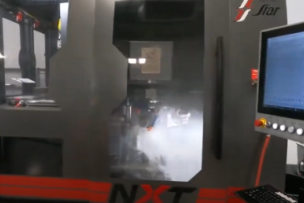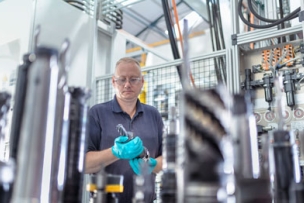Inefficient grinding operations hurt the bottom line. Learn how and where you can smooth out your grinding operation for maximum impact on time and materials.
You may have heard something similar to this over the course of your machining and manufacturing life: Grinding is a black art. No matter how good the equipment, the wheel or the fluids, a certain amount of “wizardry” is needed to produce the desired results. Much has changed over the years in technology and technique, so grinding is not really considered a well-executed magic trick anymore. But there are still aspects of grinding that require research, smart planning and old-fashioned trial and error to reach finished product and delivery objectives.
Unfortunately, unpredictable grinding processes can affect other parts of the shop floor. Because grinding is often the last operation before shipping, a backlog in the grinding department impacts overall throughput. Scrapped parts here mean scrambling to turn and mill replacements. And because CNC grinders are some of the most expensive machine tools in the shop, low efficiency hurts the bottom line.
Embracing Cylindrical Grinding and Grinding Wheels
Take cylindrical grinding: Anyone making shafts, splines, gears or impellers is familiar with this type of grinding. The smart shops are those that are grinding parts in-house, where they have the greatest control over price and delivery and are on the cutting edge of technology use—such as aerospace and medical device and parts operations. Yet these shops are exactly the type most likely to agree with a “magical” opinion of grinding: Unless in-house grinding is all you do, you probably won’t be on the cutting edge. The good news in this case is that there’s plenty of low-hanging fruit to improve grinding operations.
Start with the wheel. The bewildering array of grit sizes, bond and abrasive types, grain structures, and hardness grades found on any wheel manufacturer’s website or catalog is not a bunch of marketing hype. If you grind many different material types, at different hardness levels, in different part sizes, shapes and features, you will need a spectrum of grinding wheel options. With grinding wheels, more than anywhere in manufacturing, there’s no such thing as “general purpose.”
Keeping Your Grinding Operation Cool with Machine Lubricant
Grinding fluid is equally important. So-called neat oil is the most lubricious, reducing friction and therefore heat, but it does a poor job of removing whatever heat does remain. This can negatively impact part accuracy. Water-soluble fluid does an excellent job at cooling the workpiece but is not a great lubricant, which is why fluid manufacturers add EP (extreme pressure) compounds such as sulfur and chlorine to the mix.
Here again, there is no all-purpose fluid, although water-soluble is probably the closest. Further complicating the discussion is the type of wheel being used—resin-bonded wheels, for example, work best with oil, whereas a coarse, vitrified wheel almost always thrives on water-based fluid. More important than the type of fluid, however, is how you filter it: If you’re pumping muddy water through your grinding machine, you might as well go home for the day.
Keeping Track of Your Grinding Operation: Document What Works and Take Advantage of Technology
Everything you just read applies equally to surface, centerless and internal grinding. Whatever the application, let’s assume for a minute that you have the perfect wheel and your grinding fluid is cleaner than a G-rated movie.
Can you answer the following questions?
- What’s the proper infeed amount?
- How fast should I traverse?
- What’s the right surface speed (that is, rpm) for the grinding wheel and material?
- Do I have enough spindle power?
- How long should I spark out?
- How often and how much should I dress the grinding wheel?
- What did we do last time to make it work?
It’s this last question that might be the most important, and it is the easiest to resolve. Grinding is an iterative process. There are simply too many variables to make a best guess and cross your fingers. And while there’s a lot of good advice out there, optimization is about testing and documentation.
Keeping track of a job’s final operating parameters, as well as what was tried, what worked and what didn’t, doesn’t have to be a big deal but it is important. You should document it electronically rather than on paper—in a spreadsheet or Word document—so that you can search through your notes. Better yet, ask your grinding machine builder if there’s a software package available (often called a management suite) for this task, or see if there’s any way to put the information into your company’s ERP system (you do have an ERP system, yes?).
The bewildering array of grit sizes, bond and abrasive types, grain structures, and hardness grades found on any wheel manufacturer’s website or catalog is not a bunch of marketing hype.
And if by any chance you’re looking at a new CNC, ask about its Industry 4.0 and Industrial Internet of Things capabilities. An increasing number of CNC grinders (and all machine tools, for that matter) are getting “smart.” Remote monitoring with text and email alerts is fairly common. Onboard sensors to track machine temperature, power consumption, wheel usage and identification—these and other sources of data promise to eliminate process variability, improve part quality and productivity.
There’s a brave new grinding world on the horizon. Maybe it’s time to explore it.
How do you get the most out of your shop’s grinding operation? Share your best practices.




Talk to Us!
I appreciate that you've discussed on the grinding wheel, especially when you mentioned that there is no such thing as a "general purpose" grinding wheel so that you can grind many different material types on different sizes, shapes, and features. While I don't have a metalworks shop or know somebody who does, I believe that even heavy-duty equipment such as a cylindrical grinding machine needs to have different grinding wheels depending on what will be made. Not only does it optimize the time it takes to work, it also makes sure that damage is minimized for the equipment. Thanks for this! http://www.gandpmachineryin.com/cylindrical-grinders/4588370768
50I like your suggestion of asking the grinding machine builder if there is management software to track the machine's efficiency. This is what my friend should look for if he pursues to acquire a grinding machine for the company he works for. As I'm sure he wants to keep a record of the machine efficiency, it would be more convenient for him if there is software which can help him do that. http://halesmachinetool.com/products-by-builder
48I have trouble with my taper I understand the concept but struggle with the time
52please send me this article
TX
51We'll send this over. Thanks for visiting.
54Do you granding tires forklift wheels 1.500 inches
53Leave a reply
Your email address will not be published. Required fields are marked *